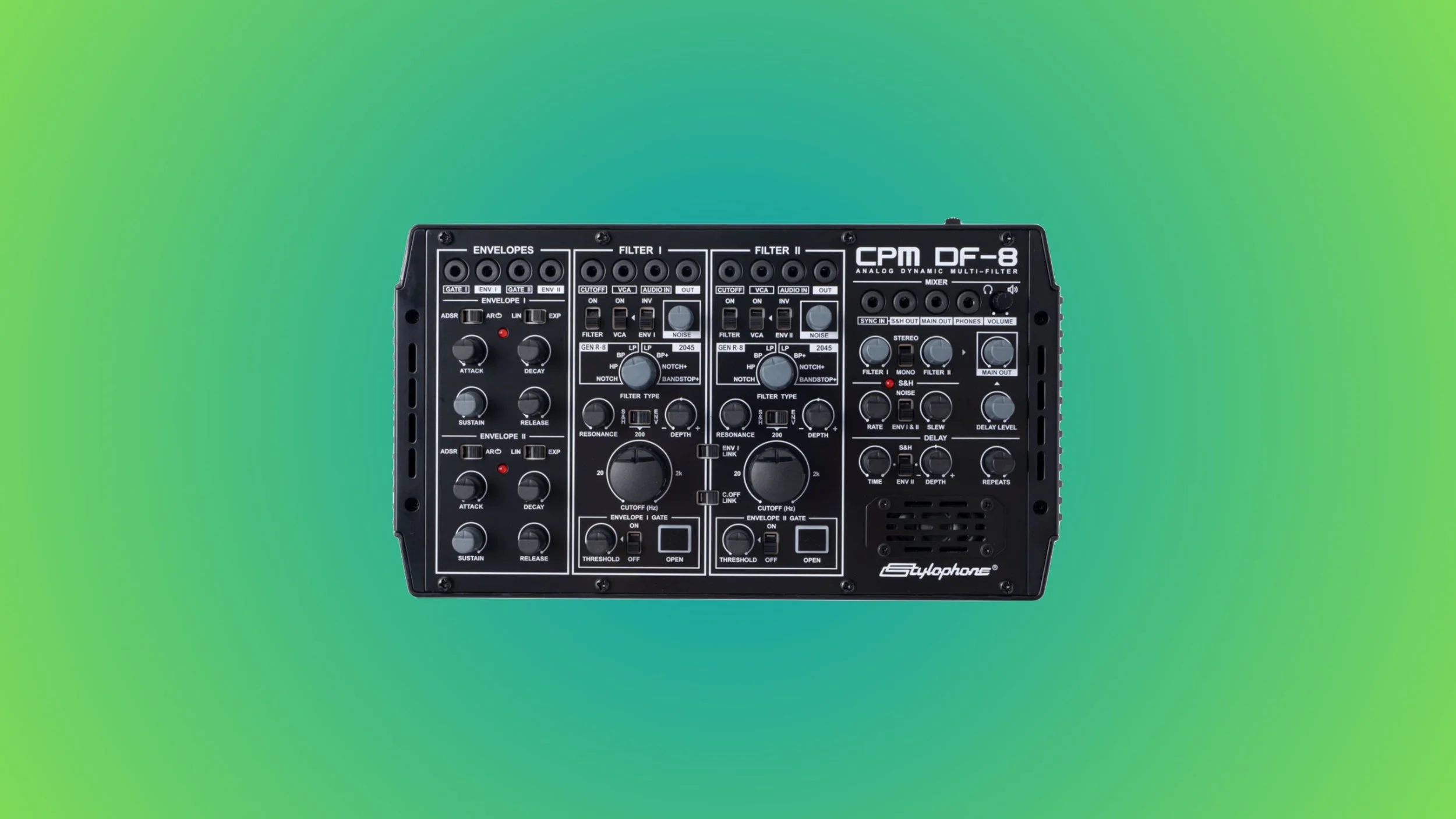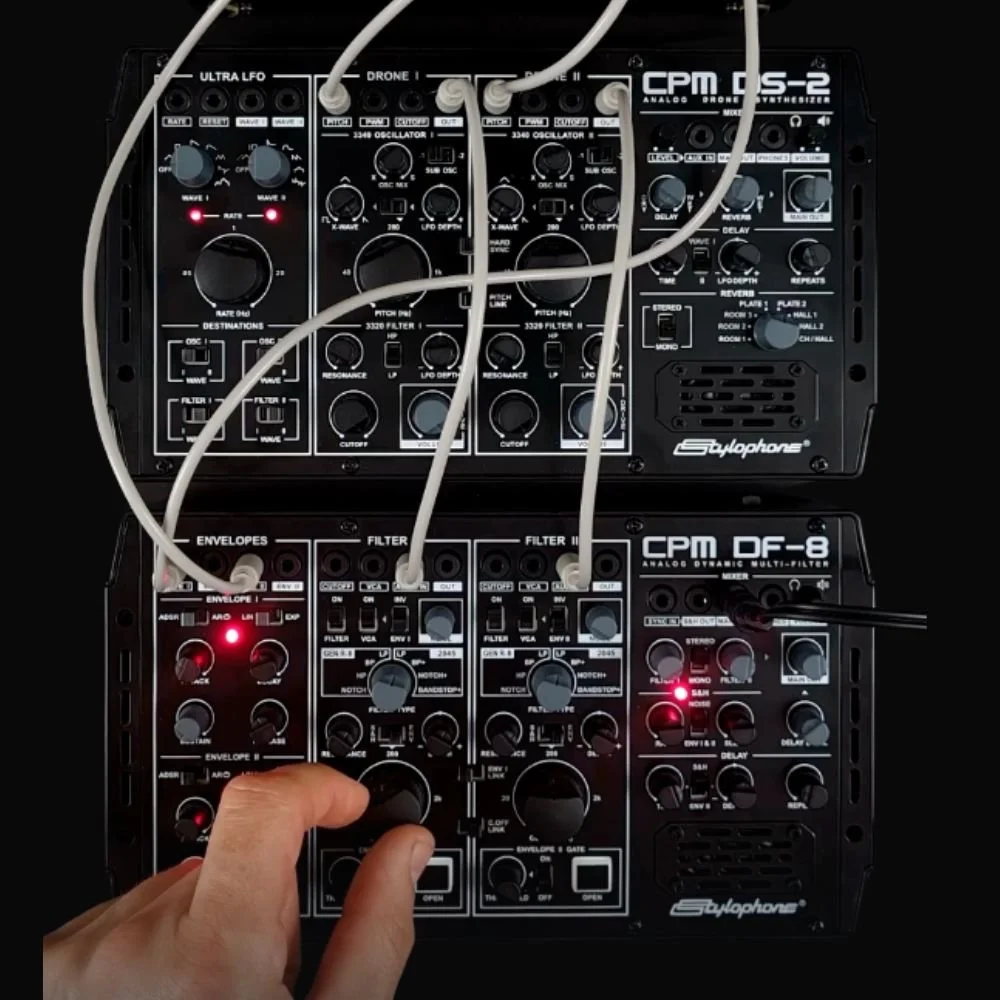Stylophone CPM DF-8: A Dual-Filter Powerhouse for Experimental Producers

The Stylophone CPM DF-8 lands in a fascinating moment for small-format hardware. Producers today want devices that are hands-on and characterful but still compact and modular enough to slot into any setup. The DF-8 fits squarely into that trend: it’s part of Stylophone’s CPM (Compact Portable Modular) ecosystem and brings serious analog sound-design power to a unit that literally fits in one hand. Instead of trying to be a synth voice or a simple filter pedal, it stakes out its own identity as a dual-channel analog filter workstation with modulation, delay, patch points, and stereo potential. It’s a “creative tool first, utility second” kind of box—something that invites experimentation rather than giving you a single obvious use case. What makes the DF-8 especially intriguing is how it blends elements of modular synthesis, desktop hardware, and classic Dubreq eccentricity. The dual filters are inspired by the GEN R-8 and 2045 circuits, the delay is a crunchy PT2399, and the modulation blocks pull from Eurorack-style thinking. On paper it reads like a laboratory: two filters, two envelopes, VCAs, noise, S&H, stereo chain options, and more. Yet it’s packaged in a format that isn’t intimidating. The pitch of this review becomes: Is this simply a quirky companion box, or is it a genuinely deep sound-design hub dressed up in Stylophone’s idiosyncratic styling?
Disclosure: This site contains affiliate links. If you book or purchase through these links, I may earn a commission at no extra cost to you. This helps support the site and keeps my content free. As an Amazon Associate, I earn from qualifying purchases.
Design & Interface
Physically, the DF-8 feels sturdier than its toy-adjacent appearance might suggest. The ribbed sides are not just cosmetic—they’re designed so multiple CPM units can slot together, creating a surprisingly stable modular row without committing to a Eurorack case. The presence of a 2W speaker adds an unexpected “pick it up and jam anywhere” feel, which practically means you can experiment with patches on the couch, at a café, or backstage without needing a full monitoring chain. Power flexibility is another strong design move: battery, external PSU, or Eurorack power bus. It’s a device that respects both spontaneity and integration, something many modular-adjacent products struggle to balance.
The panel itself is densely packed, but the layout is thoughtful. Each channel mirrors the other, so once you learn one, the second is intuitive. Knob travel is smooth, the switches give satisfying feedback, and the patch points are spaced enough to avoid cable clutter swallowing the controls. The workflow encourages a “touch and try” mindset—you immediately see how modulation flows across the front panel, and the visual symmetry helps you understand stereo and dual-filter routing options. It’s not a beginner’s interface, but it’s also not the kind of box where you spend ten minutes looking for a control that logically should be somewhere else.
Features & Specs
At the core of the DF-8 are its dual analog filters, and these aren’t afterthoughts—they’re the whole identity of the machine. Each channel offers GEN R-8 multimode filters (LP/BP/HP/Notch) that are known for their slightly wild, characterful behavior, plus the smoother and more stable 2045 low-pass for classic sweeps. The additional hybrid modes combine slopes from both circuits, allowing for shaping that goes beyond standard multimode boxes. The filters can run in parallel or be chained creatively, and the way they respond to modulation is where the instrument truly opens up. When paired with envelopes or S&H, you can move from clean stereo movement to aggressive, tearing feedback textures.
Beyond the filters, the modulation architecture is surprisingly deep. Two AD/ASR-style envelopes can be triggered by multiple modes: gate in, audio threshold, manual tap, or auto-repeat—meaning the envelopes can loop like LFOs. White noise generators, sample-and-hold with adjustable slew, envelope inversion, and a pair of VCAs further expand the signal-shaping capabilities. Add to that the PT2399 delay, which brings a lo-fi, gritty, slightly chaotic echo character that meshes beautifully with resonant filter tones. With fourteen patch points, the DF-8 steps into semi-modular territory, letting you reroute signals, modulate both channels independently, or integrate external control sources. It’s legitimately a small sound-design sandbox.
Sound & Performance
Sonically, the DF-8 spans a much wider range than typical filter units. The 2045 low-pass is smooth, stable, and capable of classic subtractive textures, especially when pushed into resonance. Meanwhile, the GEN R-8 filter modes feel more alive—squealing, biting, and occasionally unpredictable in a musical way. Sweeps can go from creamy to aggressive, and when both filters are used together you can create stereo width, shifting harmonics, or complementary frequency bands that respond differently to modulation. The DF-8 excels at movement: evolving drones, rhythmic pulses, percussive chops, distortion-leaning growls, and everything in between.
The modulation and delay unlock the more experimental side. Looping envelopes allow for LFO-like motion, the sample-and-hold can carve jagged sequences or subtle drifting textures, and the delay shifts everything into a spacey, almost tape-echo-meets-circuit-bent territory. Workflow is immediate—twist a control, hear something new—but it’s also deep enough to reward methodical exploration. The DF-8 sounds best when treated as an instrument rather than an insert effect: feed it synths, drum machines, vocals, or noise, and it becomes a performance tool. The only caveats are that the PT2399 delay can introduce grainy noise at longer times (part of its charm, but not for everyone), and the resonance can get borderline unstable at high levels.
Alternatives
If you’re comparing options, the most direct alternatives are modular dual-filter modules, stereo filters, and small desktop filterboxes. Eurorack options like the Behringer Swords, Doepfer A-121d, or A-106-5 offer clean multimode filtering at lower prices, and they integrate beautifully into racks—but none include the DF-8’s onboard delay, envelopes, S&H, speaker, or power flexibility. On the desktop side, older units like the Korg Monotron Delay or MFB filters scratch the “cheap and quirky analog” itch, while boutique options like the Sherman Filterbank offer extreme shaping at a much higher cost. The DF-8 sits in a sweet spot: more modular and more capable than budget boxes, less intimidating and expensive than full-blown filter monsters.
The real alternative question is philosophical: do you want a filter or a sound-design mini-instrument? If you only want a clean stereo low-pass for mixing duties, the DF-8 is overkill. If you want something that can be patched like a semi-modular synth, perform like an effects unit, and behave like a vintage filter on the edge of collapse, the DF-8 has few direct competitors. It’s less about being “the best filter for the money” and more about being one of the most creative compact filter environments currently available.
Pros & Cons
Pros
Inspiring workflow — feels like an instrument, not just a processor.
Surprisingly deep modulation architecture: looping envelopes, S&H with slew, noise, VCAs, envelope inversion.
Built-in PT2399 delay adds grit, space, and creative instability.
Semi-modular flexibility with 14 patch points; plays nicely with Eurorack and desktop setups.
Built-in speaker encourages spontaneous experimentation anywhere.
Cons
PT2399 delay can get noisy or unstable at long times (great for character, not for cleanliness).
High resonance settings can become unpredictable or harsh.
Not ideal for users who just want a simple, clean filter — depth comes with a learning curve.
Limited community/long-term feedback since the CPM ecosystem is still new.
Dense interface may feel cramped during heavy patching.
So… Who Is It For?
The DF-8 lands in a compelling price range, especially considering the depth of its architecture. For modular users, it functions like a dual-filter module with a bonus semi-modular environment built in. For hardware synth players, it’s a creative processor that can turn even simple waveforms into expressive, animated textures. For experimental producers, it’s a pocket-sized instrument capable of drones, percussion, sequences, weird ambiences, and chaotic feedback performances. Its value comes from versatility: you’re buying far more than a filter—you’re buying an analog character box with modulation tools normally reserved for Eurorack.
Ultimately, the DF-8 is for musicians who want character over cleanliness, hands-on modulation over menus, and a device that feels playful yet deep. If you want a traditional filter to clean up mixes, this isn’t it. If you want an inspiring little box that rewards curiosity, thrives in performance settings, and can personalize your sound, the DF-8 is a standout release. It’s one of those rare pieces of gear that feels like a creative companion rather than a utility. You don’t buy it because you need it—you buy it because it makes you want to make more interesting music.
Disclosure: This site contains affiliate links. If you book or purchase through these links, I may earn a commission at no extra cost to you. This helps support the site and keeps my content free. As an Amazon Associate, I earn from qualifying purchases.



